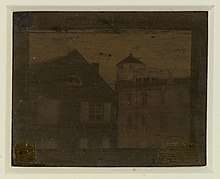Joseph Saxton
Joseph Saxton (March 22, 1799 – October 26, 1873) was an American inventor, watchmaker, machinist, and photographer from Pennsylvania. Saxton is considered to be the first known American photographer for taking the oldest known photograph in the United States in 1839.
.jpg)
Early life
Joseph Saxton was born in Huntingdon, Pennsylvania and first entered as an apprentice to a watchmaker when he was twelve years old.[1] Saxon was the son of a Mr. Saxton, a mechanic, and Elizabeth Ashbaugh, daughter of John Ashbaugh Sr. This information comes from the book "Pioneer period and Pioneer People of Fairfield, Ohio" by C.M.L. Wiseman. https://archive.org/details/pioneerperiodpio00wise_0/page/n387
Career
Philadelphia
In 1817, aged 18, Joseph Saxton moved to Philadelphia where he found employment as a watchmaker, engraver, and apprentice machinist. During this time, he made his first inventions: a machine for cutting the teeth of marine chronometer wheels and an escapement and compensating pendulum for clocks. He also constructed a clock for the newly-rebuilt steeple of the Independence Hall.[2]
England
Looking to further his education, Joseph Saxton traveled to London, England in 1828 and resided there nine years. For most of his stay he was employed by the Adelaide Gallery of Practical Science, a museum for the public that demonstrated new inventions and scientific principles.[3] While working for the gallery, Saxton invented the magneto-electric machine, an apparatus for measuring the velocity of vessels, a device for measuring the height of water in a steam boiler, the riflescope, and the fountain pen prototype.[4]
Return to the US

After almost a decade abroad, Saxton returned to Philadelphia in 1837 and accepted a position at the Philadelphia Mint, first as superintended the making of machinery and then as curator of weights and measures, accurate sets of which were furnished to national and State governments. Among his inventions of this time may be mentioned a mirror comparator for comparing standards of length and a new form of dividing engine; a self-registering tide gauge, and an immersed hydrometer.
In the fall of 1839, Saxton used a daguerreotype to take what is generally considered to be the first known photograph taken in the U.S. The image was taken from the window of his office at the Philadelphia Mint and captured the cupola of Central High School and a portion of the State Armory building.[5] It was taken on a sheet of polished metal. A seidlitz powder box with a few flakes of iodine answered for a coating box, while a cigar box and burning glass were improvised for a camera. An iron spoon served to heat the mercury to develop the plate. The picture which was produced is owned by the Historical Society of Pennsylvania.[6]
Fellow photographic pioneer Robert Cornelius, the author of the first photographic portrait ever taken, designed the photographic plate of the image.[7][8]
The first reference to the photograph appeared on 24 October 1839 in the United States Gazette.[5] An 1897 publication about public schools of Philadelphia indicates it was taken on October 16, 1839, the day after the definite account of Daguerre's process was published in Philadelphia.[6]
Later life
From 1843 until his death, three decades later, he was superintendent of weights and measures for the United States Coast Survey.[1] He died in Washington, D.C. on 26 October 1873.[5]
He was a member of the American Philosophical Society, the Franklin Institute and the National Academy of Sciences.[5] In 1843 he was awarded the John Scott Legacy Medal and Premium by the Franklin Institute for the invention of his reflecting pyrometer.[1]
See also
References
- "Joseph Saxton | The National Inventors Hall of Fame". www.invent.org. Retrieved 2019-01-04.
- Rung, Albert M. (July 1940). "Joseph Saxton: Pennsylvania Inventor and Pioneer Photographer". Pennsylvania History: A Journal of Mid-Atlantic Studies. 7 (3): 153–158. JSTOR 27766416.
- "Record Unit 7056, Saxton, Joseph, 1799-1873, Joseph Saxton Papers, 1821-1856". Smithsonian Institution Archives. Retrieved 2019-01-04.
- "Joseph Saxton". National Academy of Science. Retrieved 2019-01-04.
- Ambrose, Jenny (2008). Hannavy, John (ed.). Encyclopedia of Nineteenth-Century Photography. New York: Routledge. p. 1247. ISBN 9781135873271.
- The Public Schools of Philadelphia: Historical, Biographical, Statistical by John Trevor Custis, Burk & McFetridge Co. Publisher, 1897, Pg. 132
- Templar, Simon (31 December 2015). "Meet Robert Cornelius: He took the first Selfie in the world back in 1839". The Vintage News. Retrieved 2019-01-04.
- Johnson, Carol (2008). Hannavy, John (ed.). Encyclopedia of Nineteenth-Century Photography. New York: Routledge. p. 339. ISBN 9781135873271.
| Government offices | ||
|---|---|---|
| Preceded by Ferdinand Rudolph Hassler |
Superintendent of Weights and Measures 1843–1873 |
Succeeded by ? |